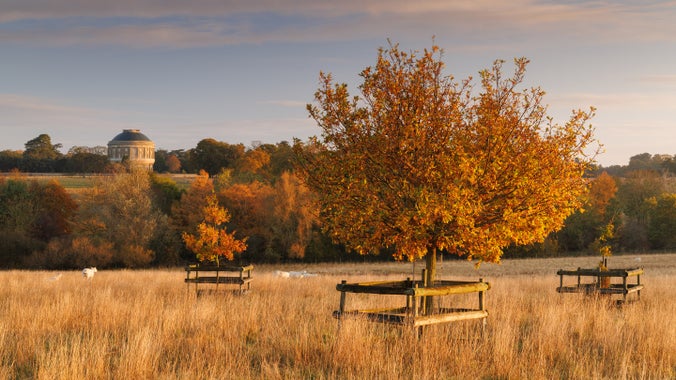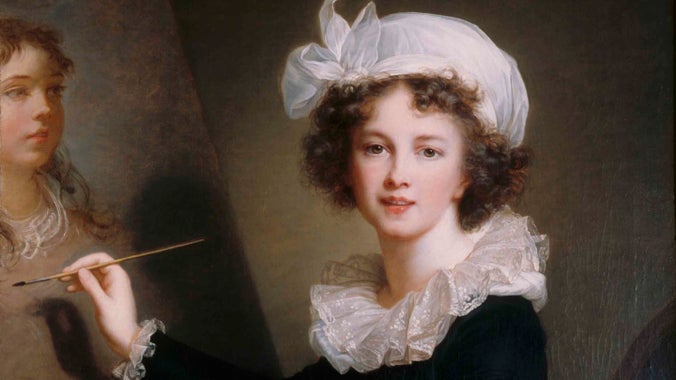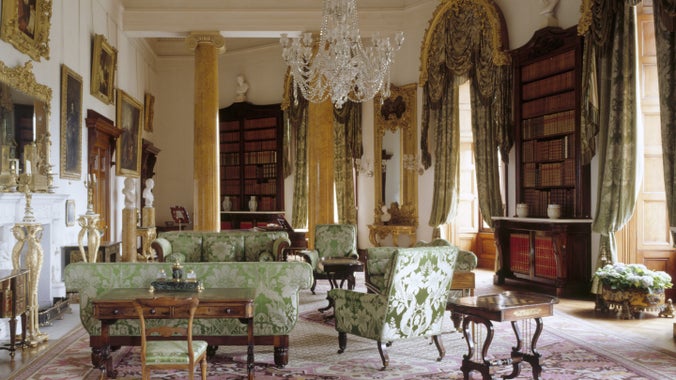
Discover more at Ickworth
Find out when Ickworth is open, how to get here, the things to see and do and more.

Ickworth in Suffolk is the creation of Frederick Hervey, 4th Earl of Bristol (1730–1803), known as the Earl-Bishop. Extravagant and grand, Ickworth reflects his passion for classical Italian architecture and his ambition to create an art gallery. Although much of his collection was confiscated by Napoleonic troops in Rome, today Ickworth contains an internationally important collection, with works by Titian, Gainsborough and Angelica Kauffman. Later generations continued the Earl-Bishop’s legacy, shaping Ickworth’s interiors.
Ickworth’s story can be traced to 1086 when Domesday Book records a small settlement of 16 households owned by the Abbey of Bury St Edmunds. By 1254, the Crown granted Thomas de Ickworth land to create a deer park. The estate stayed with the de Ickworth family until 1432. Following a long dispute, ownership passed briefly to the Drury family, and then, through marriage in 1460, to Thomas Hervey. The Herveys made Ickworth their home for the next five centuries.
During the Tudor era, the Herveys prospered. While the eldest sons focused on converting the medieval hall into a brick manor house, younger sons pursued successful careers in the courts of Henry VIII, Mary I and Elizabeth I. Nicholas Hervey (1491–1532), who famously jousted at the Field of Cloth of Gold in Calais in northern France in 1520, paved the way for his family’s prominence.
Under the Stuarts, the family maintained their royal connections, holding posts such as Commissioner, Privy Counsellor and Vice-Chamberlain. John Hervey (1616–79) served Queen Catherine of Braganza as Treasurer. Although he ensured the estate’s survival during turbulent times, he did not live at Ickworth Hall, which was leased to tenants.
In 1700, John Hervey (1665–1751) inherited the estate. Grieving the loss of his first wife, Isabella Carr (1689–1711), who was heiress to large estates in Lincolnshire, he made Ickworth his lifelong home. He described it as his ‘centre of rest...Sweet Ickworth’.
John had a prosperous political career. Elevated to Baron Hervey of Ickworth in 1703 and then 1st Earl of Bristol in 1714, he commissioned architects William Talman and John Vanbrugh, famous for Blenheim Palace, to design a grand new house. However, financial strain – due largely to his extravagant second wife Elizabeth (1676–1741), and their nineteen children – meant the family continued to live on the estate in a converted farmhouse known as Ickworth Lodge.
Instead, John devoted himself to landscaping, planting an expansive parkland and constructing the 1st Earl’s summerhouse, which is the estate’s oldest surviving structure. He also renovated St Mary’s Church the resting place for Ickworth’s owners. To expand pastureland, residents of the small Ickworth hamlet were relocated to nearby Horringer, and their dwellings were demolished.
Hervey’s eldest son and heir was John, Lord Hervey (1696–1743), a brilliant and mercurial figure. Lord Hervey and his wife Mary ‘Molly’ Lepel (1696–1768), an intellectual beauty and accomplished writer, were celebrated political movers at the court of George II and Queen Caroline.
George William, 2nd Earl of Bristol (1721–75), followed as a prominent Whig politician and diplomat, serving as Minister in Turin and Ambassador to Madrid. This resulted in the acquisition of an important silver dining service by leading Huguenot silversmiths Paul De Lamerie, Pierre Platel and Frederick Kandler – now part of Ickworth’s celebrated silver collection.
Towards the end of this life, the 2nd Earl commissioned Lancelot ‘Capability’ Brown to conduct work in the park, for which Brown received payments totaling £581 8s between 1769 and 1776. Little is known of Brown’s designs, and there is no evidence to show his work was completed.

The house you see at Ickworth today, with its distinctive classical Rotunda, was the vision of George’s younger brother, Frederick, 4th Earl of Bristol and Bishop of Derry. Educated in classical literature and inspired by classical Roman architecture such as the Pantheon and the Colosseum, Frederick sought to bring the spirit of ancient Rome to the heart of his ancestral Suffolk.
Frederick originally pursued law, a vocation appropriate to the youngest son, but found greater success in the Church. This would prove to be a profitable move. Becoming Lord Lieutenant of Ireland in 1766, he secured the Bishoprics of Cloyne and Derry, a position that was worth nearly £7,000 a year (over £1.5m today). However, his passion for travel and art collecting, often led to prolonged absences from Ireland.
The Earl-Bishop's marriage to Elizabeth Davers brought financial stability to the couple. Elizabeth inherited a fortune from her grandfather, Sir Robert Davers, who owned plantations worked by enslaved people in Barbados. The Earl-Bishop’s own inheritance of the Bristol titles and estates in 1779 also saw a rental income of £20,000 annually, roughly £2.8 million today, encouraging him to new excesses.
The Earl-Bishop aspired to build a house uniting ‘magnificence with convenience’. His choice of architect was the Italian-born Mario Asprucci (1764–1804), an influential figure among the Neo-classical artists and designers then working in Rome. Designs were subsequently adapted for the English climate by Irish architects Francis and Joseph Sandys.
The Earl-Bishop’s ambitious plans for his gallery, which started in 1795, predated the establishment of the National Gallery by several decades. Breaking from the traditional display techniques of the Royal Academy, the Earl-Bishop proposed displaying his collection chronologically and by school. The art would be displayed in curved corridors linking to symmetrical pavilions. This was to be a place of inspiration and enlightenment, exhibiting great masters like Dürer and Titian alongside contemporary artists known by the Earl-Bishop, including Angelica Kauffman and Elisabeth Vigée Le Brun.

When the Earl-Bishop died in 1803, the house was a shell. Much of his art collection was lost or seized by Napoleonic troops in Rome in 1798. His son, Frederick Hervey (1769–1859), 5th Earl completed the building. He also resumed collecting, touring Europe with his family from 1817 to 1821 to restore the estate’s cultural holdings. He also incorporated Regency ideas of glamour and comfort through his interior decorations.
In 1826 the 5th Earl was made a Marquess, in part because of his role in steering the Anti-Slave Trade Act through the House of Lords in 1807. The 1st Marquess’s inheritance from his uncles, Sir Charles Davers and General William Hervey (together totalling £1m), enabled major development at Ickworth. In 1829, he converted the East Wing into a family home, turning the central Rotunda into a gallery and grand entertaining space. The West Wing was simply built for symmetry, remaining empty until the 21st century.
He also created vast pleasure grounds and Italianate-style gardens to complement the architecture, featuring corridors of manicured hedges and towering cypress trees. This is now the earliest surviving Italianate Garden in England.
In the early 20th century, Alice Theodora Wythes (1875–1957), granddaughter of Victorian railway contractor George Wythes, brought a vast fortune to Ickworth upon marrying Frederick, the 4th Marquess (1863–1951). Her inheritance – totaling around £1.5 million today – paid for the settling of debts and major improvements to the house: new servants’ quarter rooms, electric lighting, the latest in Edwardian plumbing and renovations to the Rotunda showrooms.
Post-war decline marked the end of the Hervey’s direct stewardship. In 1956, the 4th Marchioness presented the house and estate to the Treasury in lieu of death duties. The Treasury passed Ickworth to the National Trust, opening it for public enjoyment.
The Herveys remained in residence in the East Wing until 1996 when John, Lord Bristol (1954–99) reverted the lease back to the National Trust.
For 70 years the National Trust has maintained and enhanced Ickworth, developing it as a major visitor attraction, and safeguarding its exceptional art collections. Recent projects include renewing garden planting, undertaking major conservation works and re-presenting parts of the house as exhibition spaces.

Christie, C. The British Country House in the Eighteenth Century, Manchester University Press, 2000.
Fothergill, B. The Mitred Earl – An Eighteenth-Century Eccentric, Pimlico, 1988.
Jackson-Stops, G. The Country House in Perspective, Pavillion Books, 1990.
Rothwell, J. Silver for Entertaining: The Ickworth Collection, Philip Wilson Publishers, 2016.

Find out when Ickworth is open, how to get here, the things to see and do and more.
Ickworth is home to one of the most important collections of 18th-century silver in Europe. Learn more about the collection at Ickworth in Suffolk.

Discover the house and the treasures collected by the flamboyant 4th Earl of Bristol at Ickworth, a magnificent Italianate palace in the heart of Suffolk.

Brown designed landscapes that fitted in seamlessly with the surrounding countryside. So how do you spot the designs of one of the greatest gardeners of all time?

Learn about people from the past, discover remarkable works of art and brush up on your knowledge of architecture and gardens.
